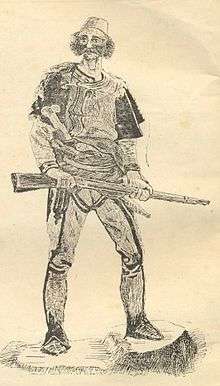Oso Kuka
| Oso Kuka | |
|---|---|
 Drawing of Oso Kuka, from the June 1901 issue of the Albania newspaper of Faik Konica | |
| Born |
c. 1820 Shkodër, Ottoman Empire |
| Died |
1862 Vranjina |
| Nationality | Ottoman |
| Other names | Osman Kuka |
| Occupation | a border guard and commander |
| Years active | 1862 |
| Known for | Blowing up the tower of Vranina |

Oso Kuka (c. 1820-1862) was an Ottoman Albanian border guard. Surrounded by Montenegrin soldiers in a tower in the island of Vranjina, he blew it up killing himself and many of the Montenegrin soldiers. In the following decades, he became a rallying figure of the Albanian independence movement and a much-celebrated character of important works in Albanian literature.
Life
Born around 1820 in Shkoder, Oso Kuka was a border guard on the Ottoman-Montenegrin border.

Oso Kuka himself had formed a 24-man band (çetë) that was active in the city.[1] At the head of a small group, Oso Kuka arrived on the battlefields where 8,000 Montenegrin soldiers had been besieging the fort of Vranjina. Kuka and his groups were defending a secondary tower in front of the main tower. When it was surrounded, instead of surrendering, Kuka planted explosives in the tower, which he activated when the Montenegrins stormed the tower and killed many Montenegrin soldiers along with his group.[2]
Legacy
Oso Kuka over the decades became a major rallying figure of the Albanian national awakening. One of the most important representations of Oso Kuka in literature is that in Gjergj Fishta's epic Lahuta e Malcis. Oso Kuka's involvement in the war and his death comprise the first five cantos also known as the "cycle of Oso Kuka".[3] Ndre Zadeja also wrote a melodrama titled Oso Kuka, based on his life.[4]
His residence in Shkodër houses the city's historical museum, while Slavic speaking population of the small village in Vranjina (modern-day Montenegro) show to visitors so-called "house of Oso Kuka".[2]
Lahuta e Malsis (The Highmountain Lute)
In the more heroic, epic tale of Oso Kuka in Gjergj Fishta's Lahuta e Malsis he is described as a highlander who descends down from the mountains to meet up with the Pasha of Shkodra. He is described to be angry because of a speech the Pasha made saying that the Albanians are passive because the Montenegrins are killing shepherds and are getting away with it. When Oso Kuka arrives to the Pasha he asks him not to say such things again and that if Oso Kuka is given a few men he will protect Albania but specifically Vranina from the Montenegrins (back then Ottoman Empire). At the same time an Albanian shepherd named Avdi Isa is guarding his cattle in Vranina. When the Montenegrin commander Vula Radoviq and his troops arrive to Avdi Isas meadow they ask him to hand over his cattle to the Montenegrins to which Avdi Isa refuses. Fighting endures and Avdi Isas rifle fire off too early, enabling the Montenegrin to kill him. After he is dead, the Montenegrins steal his sword, his rifle, his cattle and his vest, something that is forbidden according to custom. The he-goat flees and when Avdis sister sees it running she begins to mourn his death. Upon hearing the mourning Oso Kuka is enraged and encourages his friends to avenge Avdi. The bandits are tracked down and killed and the tower of Vranina retrieved. However Djokovic Pera, the Montenegrin general, is enraged when hearing upon the loss and demands 500 rifles to destroy Oso Kuka and his men and to retrieve the tower of Vranina. When the Montenegrins attack, Oso Kuka is left with a few men after several sieges and instead of surrendering, he climbs up to the top of the tower and yells "Hold on there Djokovic Pera! May you be cursed! Never have you seen an albanian blow up himself". When Oso Kuka opened fire to the gunpowder barrel, the entire tower of Vranina exploded and 500 Montenegrin soldiers were killed.
Sources
- ↑ "Oso Kuka, hero me vulën e popullit, jo të qeverisë". Gazeta Shqip. Retrieved 28 January 2013.
- 1 2 Elsie, Robert (2012-12-24). A Biographical Dictionary of Albanian History. I.B.Tauris. p. 263. ISBN 9781780764313.
- ↑ Elsie, Robert (2006-01-08). Albanian Literature: A Short History. I.B.Tauris. p. 123. ISBN 9781845110314. Retrieved 28 January 2013.
- ↑ Banham, Martin (1995-09-21). The Cambridge Guide to Theatre. Cambridge University Press. p. 14. ISBN 9780521434379. Retrieved 28 January 2013.
External links
- http://www.bksh.al/gsdl/collect/revistaa/tmp/190106.html "Newspaper from 1896 by Faik Bey Konica"
- http://shkoder.net/oso_kuka/ "Oso Kuka - A Great Hero"
- http://argophilia.com/albania/lake-skadar.html "Lake Skadar"
- http://dome.mit.edu/bitstream/handle/1721.3/147464/204131_cp.jpg?sequence=1 "House of Oso Kuka"